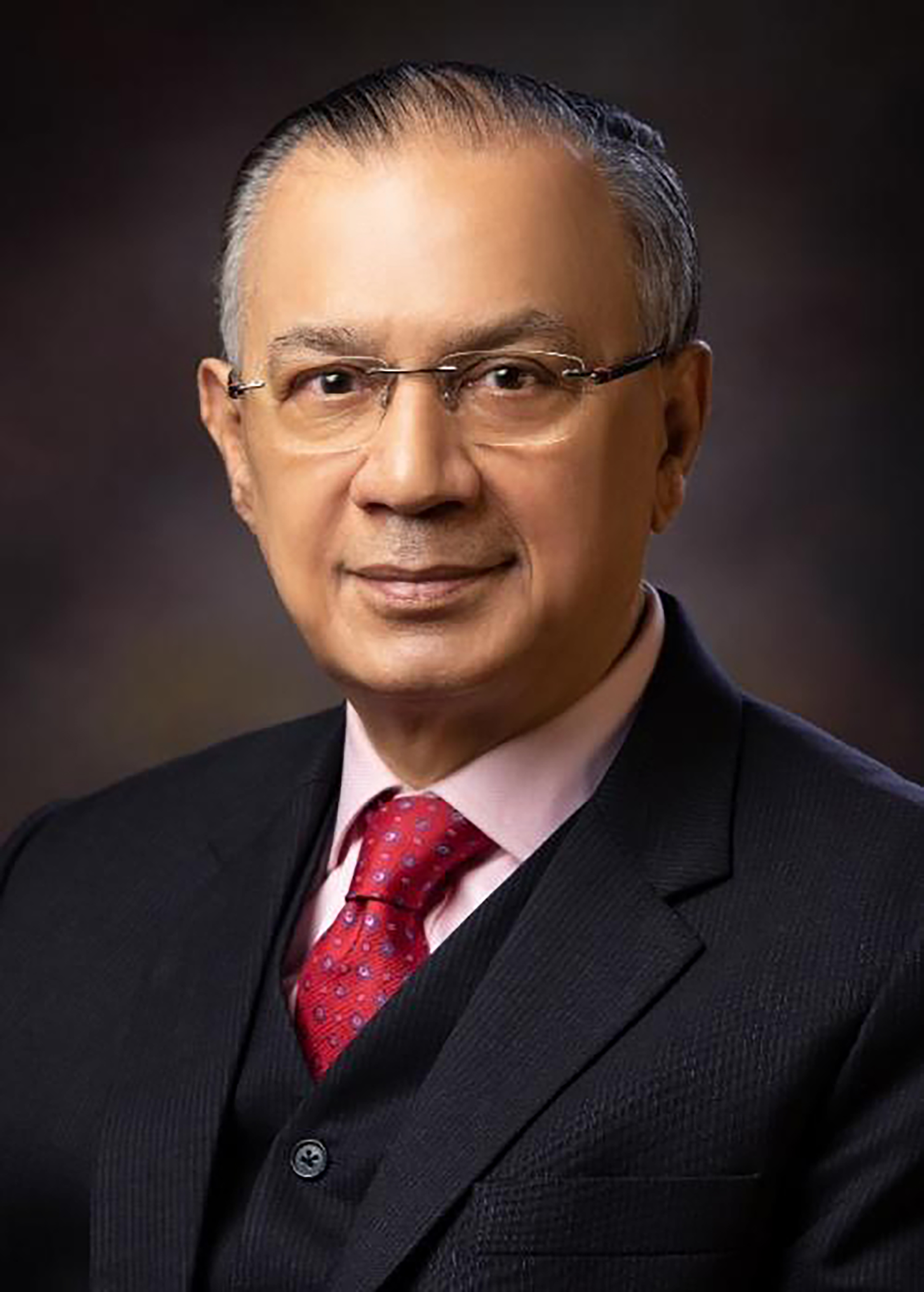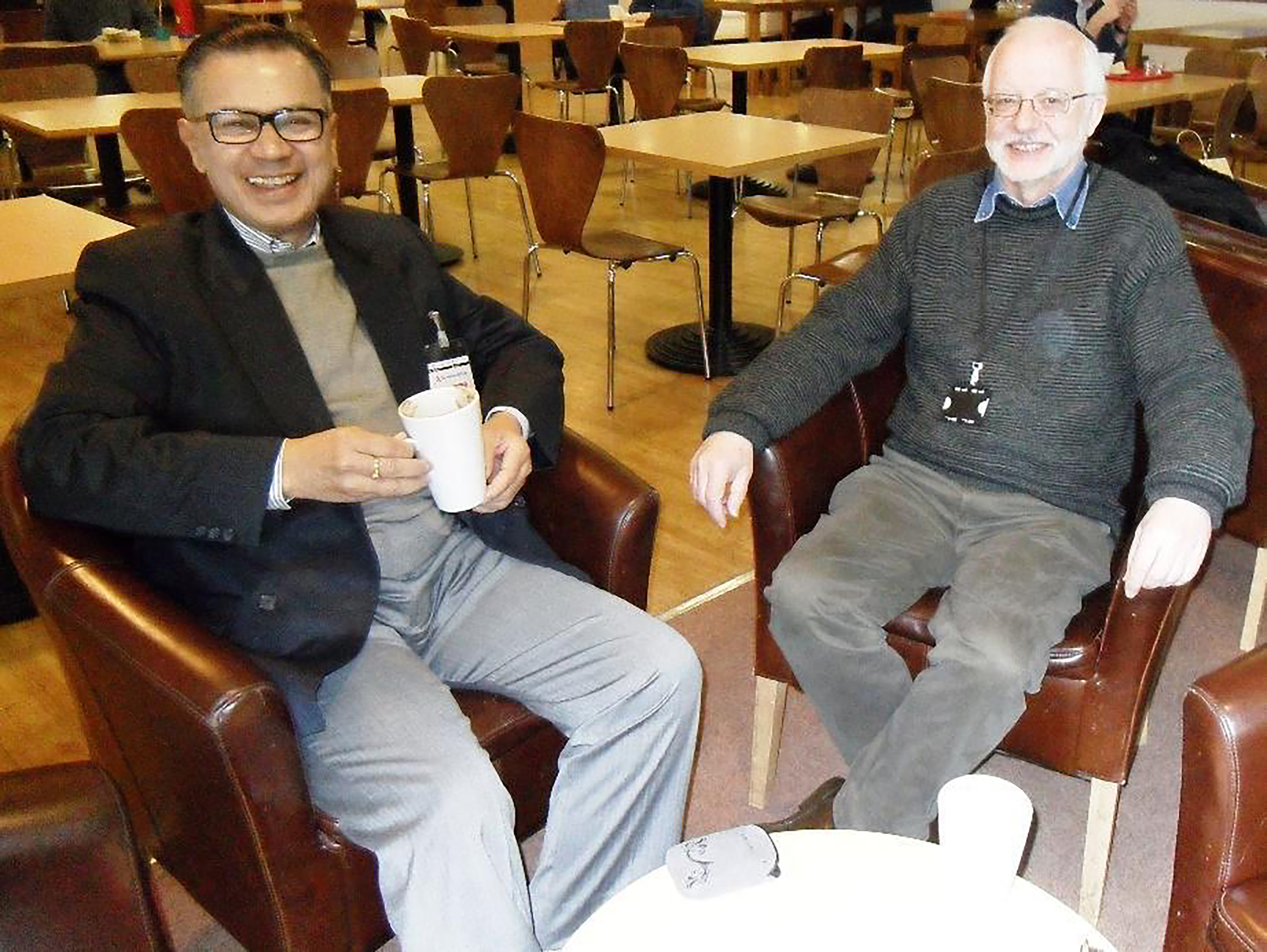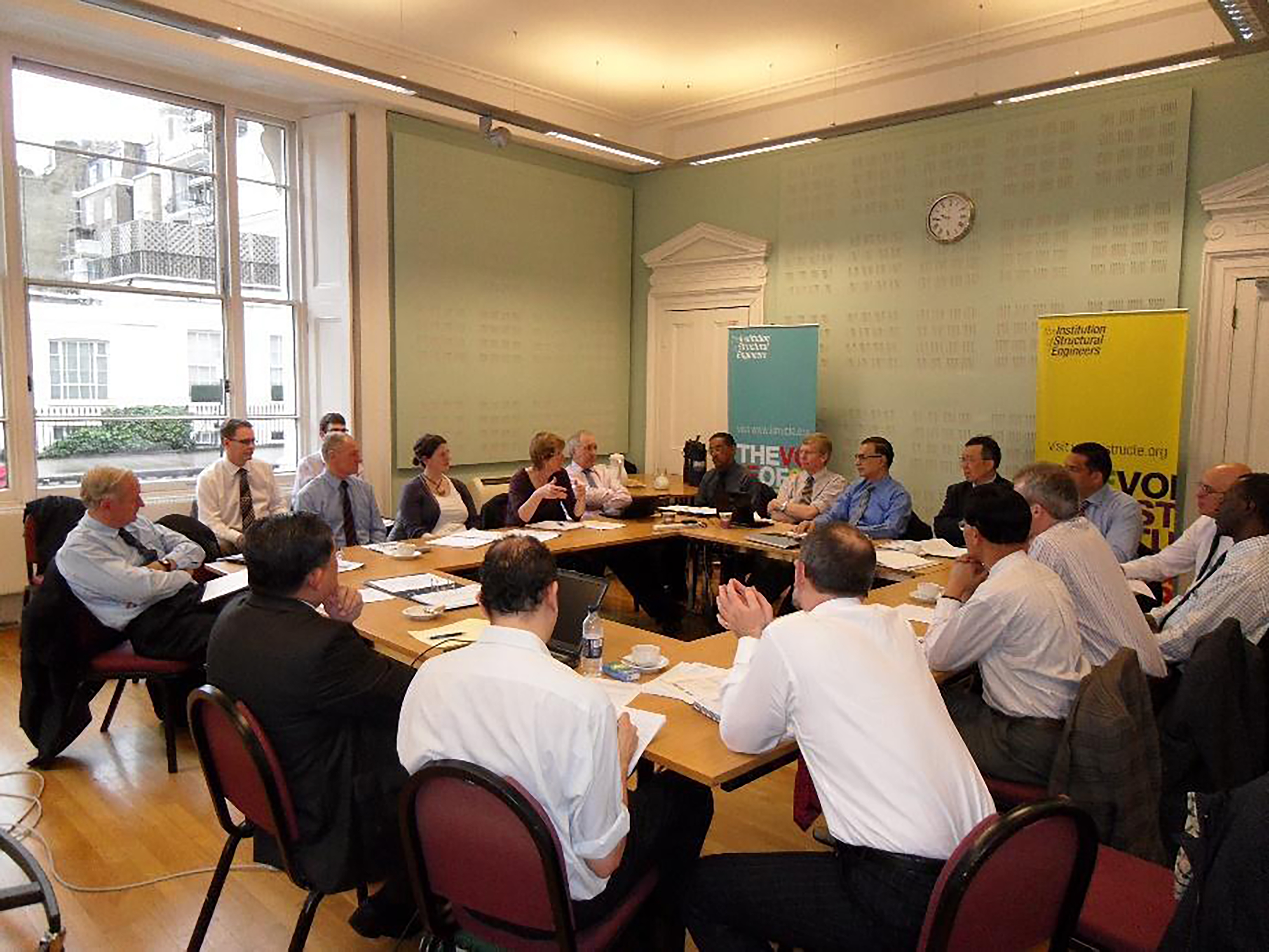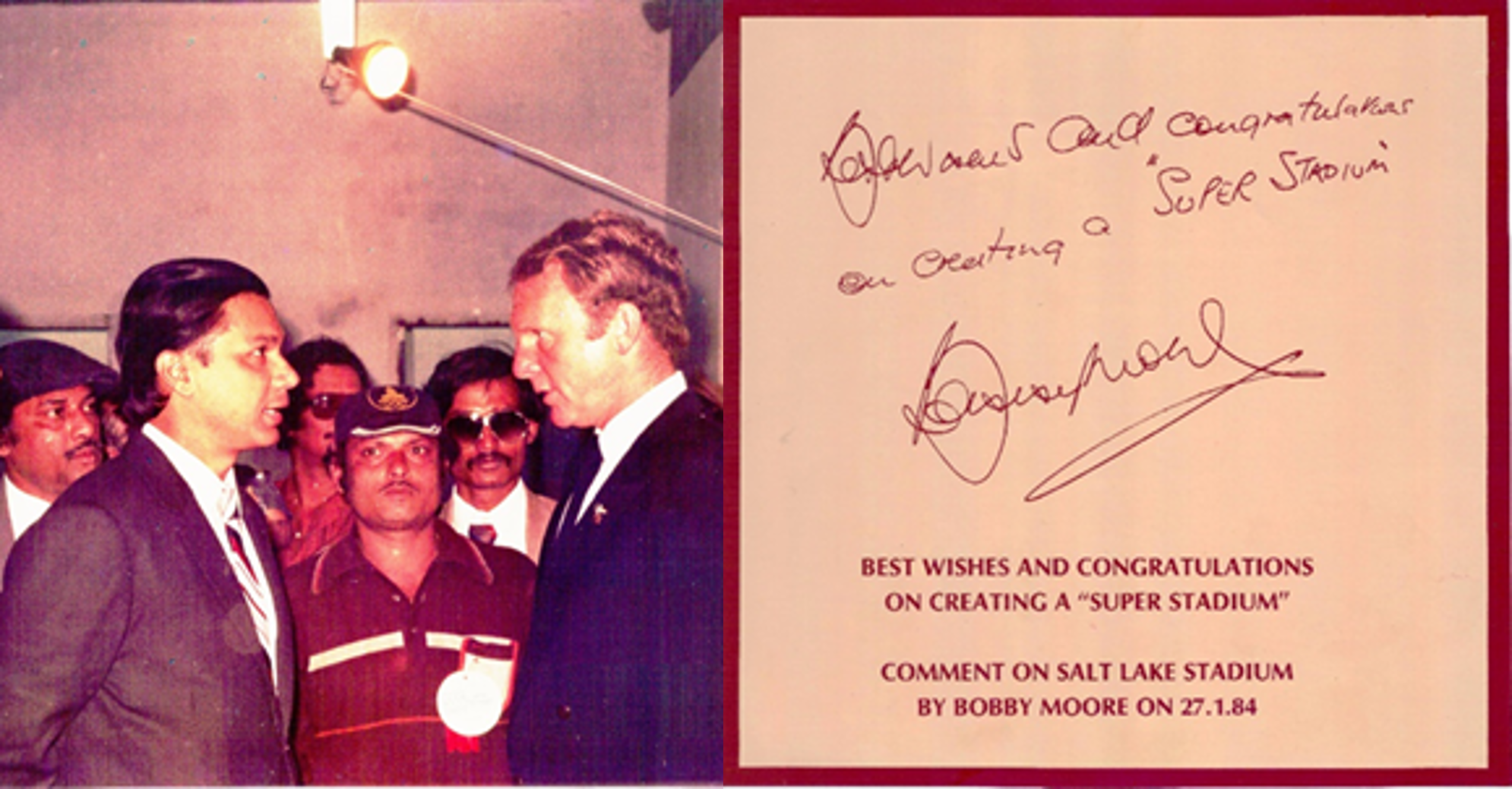Dr Hirak Sen

Dr Hirak Sen (PhD Structural Engineering 1969) joined Imperial during London’s swinging sixties, as the Beatles '65 album was jumping to number one.
In halls of residence, Hirak remembers how one listened endlessly to 'A Hard Day's Night'. The world would shortly rock with 'Yellow Submarine' and 'Eleanor Rigby'. Like millions of others across the globe, he too, became a Beatles fan.
However, Hirak wasn’t just immersed in popular and student culture. He was an ambitious engineer in the making and lover of architecture, sports and the arts. In his days at the College, Hirak was cultivating a lifetime of inspiration. After graduating, he went on to found his company, H. K. Sen and Associates.
Many years and successes have now passed since 1966, when Hirak was watching the FIFA World Cup as a student at Wembley Stadium, and he imagined himself designing a major stadium in India…
What did you learn at Imperial, in class or out?
I would condense what I learnt at Imperial into seven invaluable lessons:
- In my subject: Imperial refined my analytical and experimental research skills and sharpened my confidence. I learned how to tweak analytical models progressively until predictions matched experimental results to an acceptable degree of accuracy, giving me the skills to tackle many novel structural engineering problems.
- As for shaping my career: at Imperial I was exposed to such a galaxy of civil engineers, which encouraged me to evaluate my place in the global matrix of engineers. Mentors and peers continually reviewed my research work - reviews were credible markers of my competence as a structural engineering researcher and empowered me with confidence in my abilities. I found myself thinking gratefully about these peers and mentors as I took on complex structural engineering projects later in life.
- Hard work has no substitute: I observed how untiringly my professors and colleagues worked despite being brilliant. I saw how an outstanding undergraduate track record wouldn’t necessarily translate into doctoral success if diligence wasn’t applied. It was a harsh reminder that brilliance is not enough. I believe talent is developed - one needs to work with dedication.
- Without innovation, there is no solution: Imperial taught me the importance of pushing the boundaries gradually. The excitement of innovation and the joy of adding to the existing knowledge footprint kept us motivated.
- The value of keeping pace with emergent technology: I was at Imperial during the dawn of computing and programming for research. I had shared usage of an IBM 7090 and later an IBM 360. It was the advent of computers – these machines that would occupy large rooms had a fraction of the power of a modern PC. I quickly learned Fortran and later did all my analytical research on these computers using programs written for the specific problem. My peers and I helped each other learn programming. Our mentors depended on our skills as they couldn’t use computers, whilst mentoring us through their deep understanding of structural behaviour.
- Real world experience: we tackled industry problems as researchers at Imperial. A large consulting company came to Imperial with a problem to solve, regarding the most complex junction on the British motorway network, a free-flowing interchange on four levels. I was trusted with this work because one of my peers and I had already developed a computer program for the same problem. We found a satisfactory solution to the issue under the guidance of my mentor, Dr John Clifford Chapman, and it was hugely rewarding for me to work with the senior expert engineers of the company. Other industry experience I had involved investigating the cause of a London gas explosion using laboratory models, shedding significant light on the cause of the building collapse.
- Writing: it was at Imperial that I learned to write technical papers effectively.
Tell us about your studies at Imperial?
My research focused on interpreting and quantifying the complex interaction between steel and concrete in composite construction. It led to, among other things, rational design rules for shear connectors (such as headed weld studs) between the two materials. The outcome of research at Imperial went into formulating a part of CP 117 and informed the code of practice on composite construction published in the 1960s.
What did you enjoy outside of class?
Lots. I enjoyed squash, badminton, and swimming at the College’s sports centre in Prince’s Gardens – today known as Ethos. I would also jog through Kensington Gardens no matter the weather. Occasionally I would row the Serpentine, stopping periodically under the shade of a plane tree. I would gaze at the sky and wonder if my parents might also be looking at the same moon 5,000 miles away in India.
I soon learned that winter sports did not agree with me. But I did get into chess and bridge, against doctoral researchers who were generally very good at cerebral acrobatics, so the games lived up to decent standards. I never particularly excelled in any of these sports or brain games, it was simply taking part that made my life much richer and more enjoyable.

I would avidly visit London's famed art galleries and museums and book ballets and plays - Agatha Christie's 'Mousetrap' and John Osborne's 'Look Back in Anger' were noteworthy. Once, I queued overnight at Covent Garden to buy tickets for a ballet by Margot Fonteyn and Rudolph Nureyev - the trouble was more than adequately rewarded. On other occasions, I was held spellbound in Regent's Park Open Air Theatre experiencing Shakespeare’s 'A Midsummer Night's Dream', whilst the open-air orchestra at Holland Park enraptured me. The annual Chelsea Flower Show was also a fixed event in my diary, and I have colourful memories of visiting Kew in springtime.
On top of this I was a voracious reader – seeking out essays, novels and poems with the rest of my time. I’d buy thick books filled with illustrations of Western art and architecture from South Kensington Books on Thurloe Street, by the station. You can still visit the shop today.
One weekend, I sat by the window of my eighth floor room in Weeks Hall overlooking Prince's Gardens and read 'Gone with the Wind’ in a single sitting.
I believe taking an interest in both science and the arts has given me an appreciation for a holistic life. My time in the arts provided relief to my intense engineering research, which on its own, might have encouraged a narrower outlook.
Who did you find inspiring at Imperial and why?
I had the opportunity to be in close quarters with many acclaimed scholars in civil engineering, including, Professor Sir Alec Westley Skempton, Professor Arthur Lempriere Lancey Baker, Professor Alan Wilfred Bishop, Professor Stanley Robert Sparkes, and Dr John Clifford Chapman, my mentor.
Dr John Clifford Chapman
Dr Chapman, my mentor, treated all his students equally. How to describe him?
Under Dr Chapman, we complemented each other and worked without rivalry. He could easily bridge the cultural divergences between us. The unifying strand was structural engineering - everything else became secondary. He was a man in a hurry and focused on his work, with a powerful third eye that could visualise the deflected shape of any structure under a given load. He’d use his students' computer analyses merely to confirm his perceptions.
We, his mentees, and 20 years his junior, would take walks with him and we’d struggle to keep up. That is, if he wasn’t beating us at lunchtime squash. He’d walk to campus via the South Kensington station tunnel because time efficiency was his priority.
Dr Chapman was highly skilled in writing technical articles and he taught me his art. On our first collaboration, he had me revise the draft six times. When he asked me to amend the fourth version, I exasperated, “Dr Chapman, doesn't this look fine?”. He said, 'Look, there could be half a dozen ways of telling a story, and I would be willing to accept your way, even though that might be different from mine, so long as it is one of the half a dozen ways". I never quibbled about revising a draft again. When he only made a minor revision to one of our last papers, I was content to understand that I had been able to meet the exacting standards of my mentor.
On that note, I still draw comfort from what Ernest Hemingway famously said – about his tendency to write one page of masterpiece to ninety-one pages of trash, and how he tries to put the trash into the wastebasket.
I mentored three postgraduate students under Dr Chapman’s overall guidance. When I was anxious about my research, feeling like I wanted to take my investigation to the next level before writing my thesis, he convinced me that I already had enough material for a PhD. I wrote my thesis at his urging and found that it sailed through. It was later with Dr Chapman’s encouragement and support that I became a chartered member of the Institution of Structural Engineers and the Institution of Civil Engineers.
I was deeply saddened when Dr Chapman died in 2011 at age 88. I dedicated an article to him on my blog, and I feel very privileged to have crossed paths with him.
Professor Stanley Robert Sparkes
Professor Sparkes was Head of Structural Engineering when I was at the College, and an extraordinary human being who laughed heartily and encouraged unreservedly.
I remain indebted to Professor Sparkes in many ways – his thoughtful concern for me when I was early at Imperial eased my initial financial constraints, as he supported my subsequent employment by the College. He later supported the renewing of my visa application, explaining to the British visa officer that if I returned to India, it would be a “loss for Britain.”
I fondly recall being invited to dinner at the home he shared with his wife in Harrow-on-the-Hill, where we watched his brand-new colour television - a completely new experience for me and many of the other guests.
Denis Denness
I was also blessed to have met Denis Denness, and later his wife, Joyce, and their son.
Denis was a dedicated lab technician and worked on the lab experiments of my research projects. Denis assembled my experimental setups and supported testing. He had large smiling eyes and was often seen wearing a trench coat, carrying his homemade sandwich for lunch. His demeanour was kind towards everyone, and he was highly skilled in his role. The Denness family regularly invited me to their home for Sunday lunch. After a delectable four-course meal, we would animatedly discuss everything over cups of coffee and lumps of chocolates. Our families became lifelong friends.
There were other technicians too - I remain obliged to all these people who took care of every detail, resulting in the smooth conduct of experiments.
While Dr Chapman mentored me academically and Professor Sparkes safeguarded my employment, Denis supported me socially. In their different ways, they inspired me to navigate the challenges and opportunities of life in and out of the College. They have each now passed away, but their memories continue to shine.

What is your fondest memory of your time here?
It was November 1965, I was still new to Imperial. We were working at our desks after mid-morning tea, when there was a hushed murmur followed by a rush towards the windows - it was the first snow of the year. Pristine white flakes fell silently from the sky onto rooftops, cars, hats and topcoats.
Having just arrived in London from India, I had never seen snowfall before. The moment compares with my other soul-stirring first sights - seeing the majestic Himalayas in Kangra, the boundless sea in Puri, the incredible Taj Mahal in Agra, and a few years later, the impeccable sculpture of David in Florence.
What is your favourite place at Imperial and why?
The tearoom on the fourth floor of the Civil Engineering building (now Skempton).
20 of us had our desks spread between two rooms, with our tearoom sandwiched in the middle. Tea breaks would take place mid-morning and afternoon, and I’d most enjoy pairing a chocolate digestive with Tetley tea. Others might have gone for a double portion of toast slathered with butter and sugar, which used to remind me of my home in India, where we’d take similar buttered sweet toasts.
It was a happy gathering place with lively conversation. I still keep in touch with my tearoom friends today – now all eminent professionals, it has been an enriching experience for me to have crossed paths with so many great minds in that little space.
What did you like about the South Kensington location?
Walking around the College neighbourhood elevated my soul. I would soak up the Georgian architecture that dominates most of South Kensington – its symmetry, proportion, and simplicity appealing to the structural engineer in me.
The neighbourhood showcases other styles of architecture too. The V&A, in charming Italian Renaissance, is built primarily in terracotta, brick and mosaic. That said, I found the Gothic Revival and Romanesque architecture of the Natural History Museum imposing – subduing my soul and failing to charm my mind!
I travelled widely across the UK and Europe during my time at Imperial and remained enamoured with the world of Western art and architecture, exploring it wherever I went.
I went on to author a paper on the architecture and related aspects of the Victoria Memorial Hall, having long since been inspired by the works of art historian Kenneth Clark.
Tell us a bit about the work you’re doing now, and your journey to this point.
Today I run a consulting firm in India, having returned permanently in 1972.
When I first came back, I worked for a year and a half at the Calcutta office of a global consulting firm, which was designing 14km-long shore-spans of the high-level Vidyasagar Setu across the Hooghly River. I had to prepare the geometric design of the shore spans. The work was not calling upon my expertise in structural engineering, rather highway engineering. However, I had done two semesters during my MTech at IIT Kharagpur on highway engineering, which allowed me to embrace the challenge, and I worked intensely to update my highway engineering knowledge before starting. Today the bridge is a vital transportation link of national importance.
In 1973, I founded my consulting firm, H. K. Sen And Associates, and never looked back. Within 15 years my firm had over 100 employees and offices in Kolkata, New Delhi and Hyderabad. We designed and delivered many nationally acclaimed projects spanning recreational, health, educational, institutional, and industrial buildings – as well as airport buildings, roads, bridges, power houses, integrated townships, and environmental impact assessments. Some projects were opened by the Prime Ministers of India.
Over the years, these projects continue to benefit millions of people directly and indirectly. My firm has also enabled several dozen engineers, architects, and supporting staff members to attain higher skill levels and empowering them in their lives.
I have continued my professional development through affiliations with distinguished professional institutions and I engaged with volunteer work. The awards I have received for my career have bolstered my spirit.

How has what you learnt at Imperial helped you in your career so far?
Imperial ingrained into me many excellent qualities - self-confidence, an innovative approach to problem-solving, disciplined hard work and computerised solution skills.
The opportunity to solve industry problems whilst at the College gave me a deep insight into the minds of highly skilled professional designers at an early stage, which has had an immeasurable influence in my career since.
Having the Imperial name behind you, opens doors by itself.
What have been your career highlights and lowlights?
The highlight of my career has been building the Salt Lake Stadium. The space has engaged and entertained millions of people for nearly four decades so far. In 2017, it hosted many FIFA U-17 World Cup games and FIFA praised the stadium generously. Salt Lake completed my dream of 1966 - when I was a student watching the FIFA World Cup at the Wembley Stadium, and I imagined designing a major stadium in India.
The lowlight of my career might be not identifying and training the leadership succession of my consulting firm. Perhaps I was too engrossed in complex structural engineering design and coordinating the other disciplines' work to pay enough attention to building the leadership succession. If there is one word in my defence, it would be that in the Indian engineering consulting domain - unlike in the UK, there is no established tradition of ownership transfer of a consulting firm. Many consulting firms in India cease to exist following retirement of the founder or CEO.

What does a typical day look like for you now?
I remain busy with the professional, philanthropic, and social organisations I am associated with.
I also do a fair amount of writing, reading and mentoring.

What are your plans for the future?
I am shifting gradually from hands-on engineering design to horizon broadening and self-improvement activities.
In all, I plan to continue my life-long learning!
What would be your advice for current students?
Any student of Imperial can acquire world-class expertise in their discipline. They are brilliant and well-informed and do not require my advice.
On that basis, I would share the below tips for developing world-class talent:
- Dedicate yourself to training for at least 10,000 hours
- Learn from eminent mentors
- Seek out environments conducive to learning (and later working) in
- Collaborate, innovate and learn throughout your life - and publish your findings
- Undertake volunteer work, socialise, touch lives
- Dream big and pursue your dream!
In 2021 I published a piece on how civil engineers can develop world-class expertise in 6 steps.
What makes you proud to be an Imperial alumnus?
Imperial is defined by tireless academic work, multidisciplinary collaborations, and global partnerships.
The College aims to tackle some of world's most pressing challenges. Its community of staff and students are highly motivated.
Many alumni are placed in significant leadership positions in many countries across the globe.
How would you describe Imperial alumni?
Quietly self-confident.

Do you have any favourite quotes or saying?
'Know yourself' - an ancient Greek aphorism. Socrates observed in around 450 BC that knowing yourself is the beginning of all wisdom. Equally, an essential part of knowing yourself must be recognising the limits of your knowledge and understanding – understanding what you genuinely know and what you have yet to learn.
I enjoyed poetry as a student and still revisit my favourites now. One would be TS Eliot’s Four Quartets. I quote below a few of my favourite lines:
"In my beginning is my end. In succession
Houses rise and fall, crumble, are extended,
Are removed, destroyed, restored, or in their place
Is an open field, or a factory, or a by-pass”.
These lines to me hold the mysticism of spirituality that transcends ordinary understanding. Although, I suspect the destruction and restoration of houses, factories, and bypasses probably resonate with the civil engineer inside of me.
Is there anything else you’d like to share?
My stint at Imperial in the heart of London – a swinging cosmopolitan city when I was there in the 1960s, became a part of my DNA, and has remained so ever since.
Aside from London, my favourite cities are Paris, Rome, Amsterdam, and St Petersburg. I still take a keen interest in their art and architecture.

Connect with me online!
You can find me on LinkedIn here or you can follow my blog here.
Dr Hirak Sen has published the unabridged version of his story on his blog.


